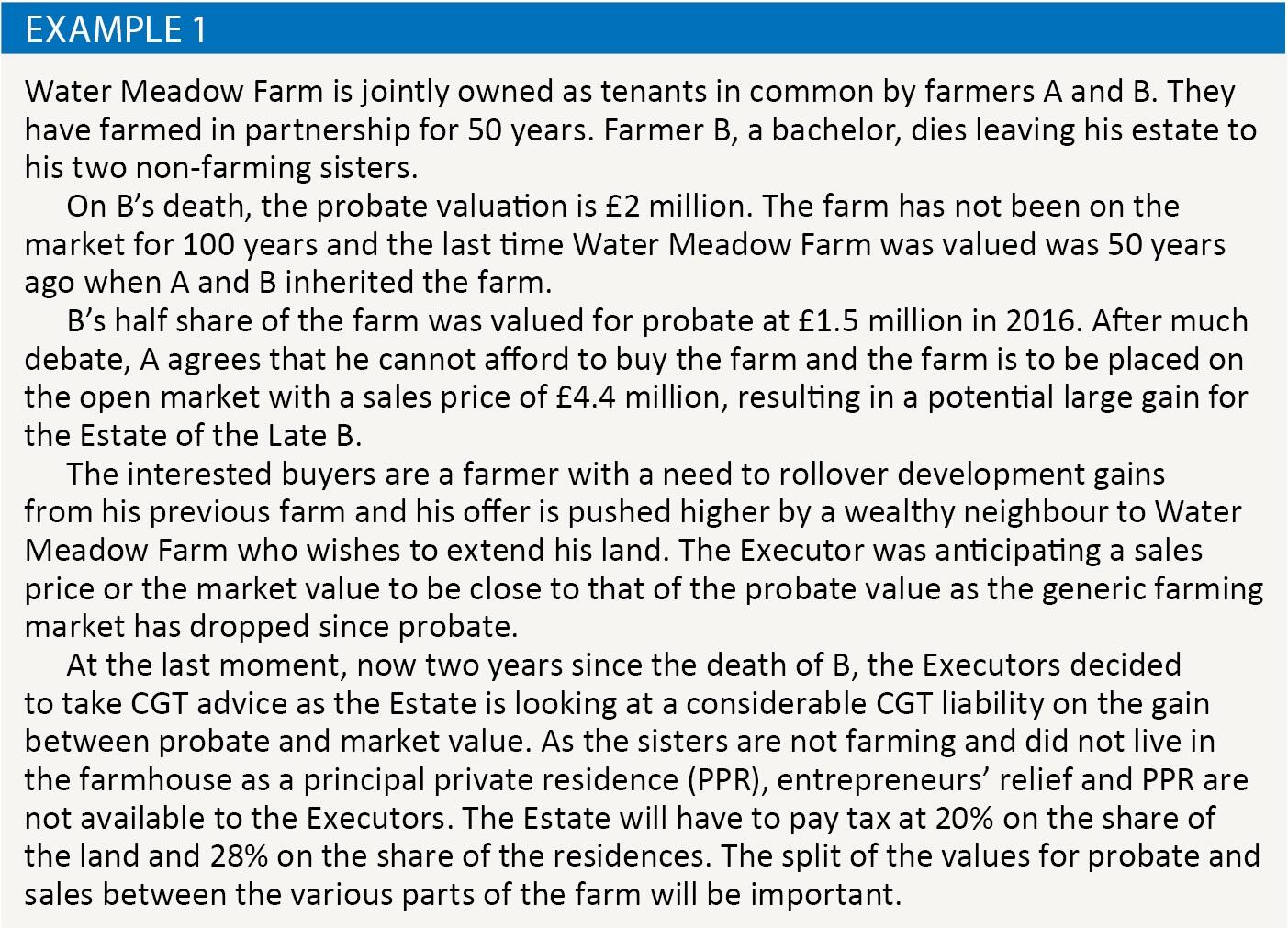CGT planning for farms

Julie Butler and Libby James examine the executors’ responsibility to capital gains tax planning on farms
Key Points
What is the issue?
CGT is often forgotten when dealing with the affairs of a deceased though its impact can be considerable when, for example, assets are sold for more than probate value.
What does it mean to me?
The appointing out of assets has to be dealt with on a case-by-case basis. It is essential to look at costs and the general inconvenience and risk versus the potential tax saving.
What can I take away?
By considering all circumstances of the estate and beneficiaries in the round, significant savings can be made on the estate’s tax bill.
CGT is often forgotten when dealing with the affairs of a deceased though its impact can be considerable when, for example, assets are sold for more than probate value. By considering all circumstances of the estate and beneficiaries in the round, significant savings can be made on the estate’s tax bill.
The importance of values when considering appointment
The probate value is the value of an asset agreed with HMRC at the date of death. This becomes the acquisition value or base cost for the estate, essentially resulting in a tax-free ‘uplift’ for Capital Gains Tax (CGT) purposes. A capital gain would then arise where the asset increases in value during the course of the administration of the estate.
Farms can increase in value during the probate period and likewise the probate valuation can prove to be cautious as the sale of the farm approaches. Estates pay CGT at the rate of 20% or, in certain circumstances, at the upper rate of 28% for sales of residential property which do not benefit from Principal Private Residence (PPR) relief. As such, CGT should always be considered by executors and administrators.
An annual exempt amount for CGT will still apply, just as with individuals, but only for the tax year in which the death occurred and the two tax years following that. This tax-free allowance is the same as that which applies to individuals, being £11,700 for 2018/2019.
Using CGT allowances of a beneficiary
An asset standing at a gain can be transferred to a beneficiary who may then go on to sell it utilising their annual exempt amount. This is known as appropriating. The beneficiary is deemed to receive the asset as legatee at the probate value and can be an effective method for saving tax if the correct planning is put in place. Obviously, the personal situation of the beneficiary must be taken into account for this; what rate of tax will apply to them? Do they have losses to offset gains? Do they still have their allowance available? For example, some beneficiaries of farm Wills might have low income, so they would be able to use the lower rate of 10% for non-residential property and 18% for residential property to the extent the basic rate band is unutilised.
It is also worth considering whether it would be logistically possible for the asset to be shared between a number of beneficiaries.
CGT and estates
Farm estates are never simple to manage and need agricultural experience. The ‘transfer’ or appropriating of a jointly held asset can thus be complex. With more farms coming on to the market to raise money in order to pay out non-farming siblings, the variance between probate and market value can vary considerably and result in CGT payable or at the very least CGT planning.
Land and building sold within four years of death
Relief for a loss on the sale of land and buildings is available where such assets are sold within four years of the date of death. This allows the land to be ‘revalued’ for inheritance tax purposes if sold for less than the probate value. However, a reduced value for IHT will result in a lower base cost for CGT and thus a view must be taken on which approach works best. The IHT relief is subject to stringent conditions not detailed here, but it is important to note in particular that appropriation of the land prior to sale will mean that the IHT relief ceases to be available.
As stated above, the personal representatives are deemed to have acquired the Estate’s assets at probate value for CGT purposes. Therefore, the gain will be calculated as the difference between the sale proceeds and the probate value. The potential for clever CGT planning should always be given its place in estate administration. The executors should handle the estate assets to best effect and the necessary advice should always be sought accordingly.
Practical problems of appropriation
Although there are potential advantages of appropriating assets to the beneficiary rather than disposing of them, it may not necessarily be practical to do so. This is especially true when the farm is involved.
For example, if an asset is left to more than one beneficiary and in the circumstances, it is not practical to transfer it to them jointly, or if an Estate has insufficient cash to settle the tax or liabilities, the personal representatives may have little choice but to dispose of the asset.
Notably, in addition to the annual exemption available to the personal representatives for the year of death and the following two tax years, a deduction is also available for the costs of obtaining probate. The deduction can be based on the actual costs of obtaining probate or the rules set out in SP 2/04.

Considering the alternatives
The costs of appropriating Water Meadow Farm to the sisters in the above example just to save extra personal allowances and lower rates of CGT of 10% and 18% will probably outweigh the CGT saving. The financial impact of both methods must be calculated and considered in the round.
The dilemma with Water Meadow Farm is that it appears that the probate value was too low. It is well known that it is difficult to value farms and even more difficult to value a farm that has not been on the open market for 100 years. However, despite the fact that generic farm prices had been falling, Water Meadow Farm’s specific circumstances meant its value went the other way. The farm had agreed strong Agricultural Property Relief (APR) and Business Property Relief (BPR) for inheritance tax and thus ironically a higher probate value would have mitigated the CGT liability arising from an increased sale price over the probate value.
In instances such as this, Principal Private Residence relief (PPR relief) must not be overlooked. PPR can be available if the Executors sell the property of the deceased if it was the beneficiary’s main residence. In the case of the latter, the property must have been the beneficiary’s main residence immediately before and after the individual’s death and they must also have a ‘relevant entitlement’ under TCGA 1992 s 225A. This means they must be entitled to at least 75% of the net proceeds of the sale of the property under the terms of the Will. These provisions can be utilised as part of overall structures.
Do the costs outweigh the tax advantages?
In summary, the appointing out of assets has to be dealt with on a case-by-case basis. It is essential to look at costs and the general inconvenience and risk versus the potential tax saving. Whatever happens the review must be carried out at an early stage in the tax planning process. It is vital for such a review to be undertaken with the full figures and costs to present to all those involved, especially those with power to make decisions.


